Breast Augmentation
Breast Augmentation in Carmel, IN
Dr. Barry Eppley is an experienced and highly skilled plastic surgeon who takes pride in closely listening to his breast augmentation patients and understanding the exact shape and breast contour they desire. To help patients achieve their goals, he offers a wide selection of breast implants. You can view the results of some of Dr. Eppley’s breast augmentation patients by visiting his breast augmentation results section.
 The contribution of the breast to a woman’s body shape and self-image has changed greatly over the years and varies amongst different cultures. At present, a fuller breasted body is desired by many women in America. Because an individual’s body build is largely determined by genetics, women may not be able to achieve this look through diet and physical exercise. In addition, the effects of pregnancy on a woman’s breasts are usually not favorable, often causing sagging and loss of breast volume. Today, through modern biomaterials technology, it is now possible to safely and reliably alter the shape of a woman’s breasts. Some with small, underdeveloped, asymmetrical, or sagging breasts may choose to undergo breast augmentation. This operation is very effective at improving the size and shape of the breast by implanting specially designed implants beneath the breast or chest wall muscles.
The contribution of the breast to a woman’s body shape and self-image has changed greatly over the years and varies amongst different cultures. At present, a fuller breasted body is desired by many women in America. Because an individual’s body build is largely determined by genetics, women may not be able to achieve this look through diet and physical exercise. In addition, the effects of pregnancy on a woman’s breasts are usually not favorable, often causing sagging and loss of breast volume. Today, through modern biomaterials technology, it is now possible to safely and reliably alter the shape of a woman’s breasts. Some with small, underdeveloped, asymmetrical, or sagging breasts may choose to undergo breast augmentation. This operation is very effective at improving the size and shape of the breast by implanting specially designed implants beneath the breast or chest wall muscles.
BREAST IMPLANT TYPES
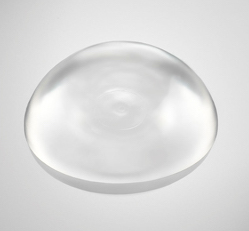 The most important decision that any woman makes about breast augmentation is the type of breast implant she chooses. Options include the base materials of saline and several types of silicone gel (cohesive gel, gummy bear breast implants). All of these breast implant materials will do an excellent job of enlarging the breast and all are FDA approved. But there are subtle differences between these material types that can affect how they feel, what incision is needed for their placement, how long they will last, how they will eventually fail (if they do) and their costs. It is important that each patient be aware of these breast implant differences so they can make the best long-term choice.
The most important decision that any woman makes about breast augmentation is the type of breast implant she chooses. Options include the base materials of saline and several types of silicone gel (cohesive gel, gummy bear breast implants). All of these breast implant materials will do an excellent job of enlarging the breast and all are FDA approved. But there are subtle differences between these material types that can affect how they feel, what incision is needed for their placement, how long they will last, how they will eventually fail (if they do) and their costs. It is important that each patient be aware of these breast implant differences so they can make the best long-term choice.
To help you choose between saline vs. silicone implants, both of which can very successfully enlarge the breasts, it is important that you understand the differences in the implants which are based on their physical characteristics. Both type implants have the identical outer shell or containment bag which is composed of a flexible silicone material. It is the internal filling (saline vs. silicone) that is different between them. Saline implants have the advantages of costing less, being able to inserted through very small skin incisions, and can be filled with differing amounts of saline between the two sides if desired. Their disadvantages are they are prone to rippling (the feeling of wrinkles along the bottom and sides of the breasts) and will eventually suffer catastrophic failure (deflation), necessitating a relatively urgent need for replacement. Conversely, silicone gel implants do not have rippling (will feel more natural) and will not suffer catastrophic failure. (and thus will last longer) Their downsides are that they will cost more, may need a slightly larger incision to be inserted and come in fixed sizes.
Gummy Bear Breast Implants
One type of implant that has caught a lot of media attention is that of the gummy bear breast implant, an urban term that describes how the silicone gel behaves when compressed. It is a more cohesive silicone gel that feels firmer. (stiffer) More importantly, if the implants should ever rupture the gel material stays together and does not change into a more liquid form. Thus there is no chance that it will migrate outside of the breast capsule and go anywhere else in the body. This is what fills all silicone implants used today and has often been given the marketing name gummy bear breast augmentation. However it is no unique and every silicone implant used today is a gummy bear breast implant. Watch the video here to see how the gel behaves when an implant is cut in half and squeezed.
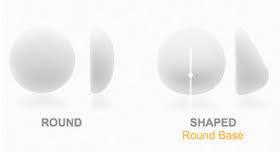 Besides choosing between saline vs. silicone gel implants, one also has the option of choosing the shape profile of the implant. Implants come in round or shaped designs which can affect how the breast looks after surgery. Round breast implants create a fuller upper pole and a rounder breast shape. Shaped implants, often called teardrop designs, cause less upper pole breast fullness and tend to create a more natural breast shape.
Besides choosing between saline vs. silicone gel implants, one also has the option of choosing the shape profile of the implant. Implants come in round or shaped designs which can affect how the breast looks after surgery. Round breast implants create a fuller upper pole and a rounder breast shape. Shaped implants, often called teardrop designs, cause less upper pole breast fullness and tend to create a more natural breast shape.
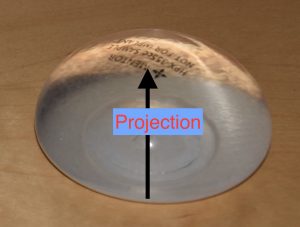 In addition to round vs. shaped breast implant designs, they come in differing degrees of projection (low, medium, high and ultrahigh) which is a measure of how wide the breast implant is compared to how much height or projection it has. Breast implant projection is more about fitting the implant to the dimensions of a woman’s chest (breast base diameter) than about influencing the final shape of the breast. But every implant volume comes in different projections so it is another and final breast implant decision.
In addition to round vs. shaped breast implant designs, they come in differing degrees of projection (low, medium, high and ultrahigh) which is a measure of how wide the breast implant is compared to how much height or projection it has. Breast implant projection is more about fitting the implant to the dimensions of a woman’s chest (breast base diameter) than about influencing the final shape of the breast. But every implant volume comes in different projections so it is another and final breast implant decision.
IDEAL IMPLANT
 A relatively new breast implant type has emerged known as the Ideal Implant. It is a saline-filled implant but it is so designed that it has some of the features of a silicone implant. For those women who do not want a silicone implant and prefer a saline-filled implant but have concerns about rippling and complete deflation, the Ideal Implant has emerged as an ‘ideal’ choice.
A relatively new breast implant type has emerged known as the Ideal Implant. It is a saline-filled implant but it is so designed that it has some of the features of a silicone implant. For those women who do not want a silicone implant and prefer a saline-filled implant but have concerns about rippling and complete deflation, the Ideal Implant has emerged as an ‘ideal’ choice.
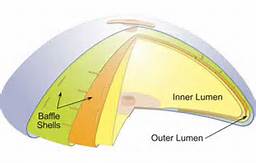 The advantages of the Ideal Implant is that it is saline-filled but does not have rippling and feels very similar to a silicone implant. It also will not ever undergo complete deflation as can occur in traditional saline implants. It achieves these physical features because of its clever internal design. With two internal chambers and series of baffles, the motion of saline inside the shell is changed. With the slowing down of fluid motion, the implant does not develop rippling and feels more firm and natural. Because of the two chambers, disruption of one chamber still allows the implant to remain partially filled and to not develop a devastating total deflation.
The advantages of the Ideal Implant is that it is saline-filled but does not have rippling and feels very similar to a silicone implant. It also will not ever undergo complete deflation as can occur in traditional saline implants. It achieves these physical features because of its clever internal design. With two internal chambers and series of baffles, the motion of saline inside the shell is changed. With the slowing down of fluid motion, the implant does not develop rippling and feels more firm and natural. Because of the two chambers, disruption of one chamber still allows the implant to remain partially filled and to not develop a devastating total deflation.
While the Ideal implant is not for every breast augmentation patient, it offers a very good compromise for those patients who have trouble deciding between silicone and saline implants or who are adamantly opposed to silicone implants.
BREAST IMPLANT SIZING
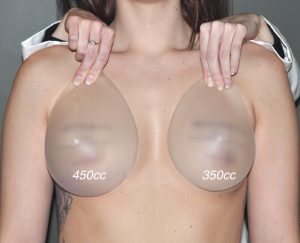 One of the most important considerations that most breast augmentation patients think about is the size of the implant. While patients think about breast cup size, plastic surgeons think about volume. (ccs) How to make the translation from implant volume to the desired outer breast look or cup size has always been a difficult one. The use of volumetric sizers helps make the breast implant size selection a much easier and more straightforward decision by trying on the different sizers. Volume is how breast implants are selected, not cup size.
One of the most important considerations that most breast augmentation patients think about is the size of the implant. While patients think about breast cup size, plastic surgeons think about volume. (ccs) How to make the translation from implant volume to the desired outer breast look or cup size has always been a difficult one. The use of volumetric sizers helps make the breast implant size selection a much easier and more straightforward decision by trying on the different sizers. Volume is how breast implants are selected, not cup size.
LARGE BREAST IMPLANTS
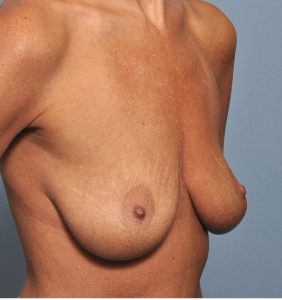
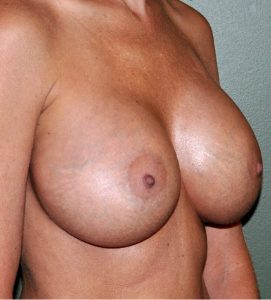 While the size of the breast implant chosen is largely left up to the patient, there are some issues that relate to getting large breast implants. Some women want large breasts simply because they want a very large size, other women want large implants to fill out a lot of loose skin. The concept of what constitutes a large breast implant size is subjective but plastic surgeons think that a large breast implant is one that goes beyond what the enveloping tissues can support long-term. This means that over time the breast tissues may weaken and the implants may drop or bottom out. At the least, if one should ever decide to go smaller after having large implants the breast tissues will be lax or sag and a lift may be needed to restore shape.
While the size of the breast implant chosen is largely left up to the patient, there are some issues that relate to getting large breast implants. Some women want large breasts simply because they want a very large size, other women want large implants to fill out a lot of loose skin. The concept of what constitutes a large breast implant size is subjective but plastic surgeons think that a large breast implant is one that goes beyond what the enveloping tissues can support long-term. This means that over time the breast tissues may weaken and the implants may drop or bottom out. At the least, if one should ever decide to go smaller after having large implants the breast tissues will be lax or sag and a lift may be needed to restore shape.
BREAST IMPLANT LOCATIONS
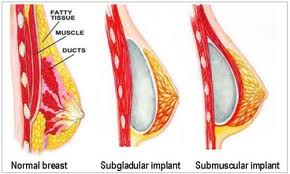 Another important consideration in breast augmentation is whether the implant should be placed above (subglandular position) or below the muscle. (subpectoral position) This implant positioning debate has been around for decades and successful results can be achieved in either location. Today the vast majority of plastic surgeons prefer the submuscular position where the results can look more natural and the risks (infection, capsular contracture) are less. To be most accurate the submuscular position for most women usually ends up as a ‘dual plane’ location. The upper half or two-thirds of the implant is under the muscle and a portion of the implant is below the muscle border in the subglandular place. (dual plane technique) This is often necessary as a completely submuscular implant for many women would have the implant being positioned too high on the chest wall.
Another important consideration in breast augmentation is whether the implant should be placed above (subglandular position) or below the muscle. (subpectoral position) This implant positioning debate has been around for decades and successful results can be achieved in either location. Today the vast majority of plastic surgeons prefer the submuscular position where the results can look more natural and the risks (infection, capsular contracture) are less. To be most accurate the submuscular position for most women usually ends up as a ‘dual plane’ location. The upper half or two-thirds of the implant is under the muscle and a portion of the implant is below the muscle border in the subglandular place. (dual plane technique) This is often necessary as a completely submuscular implant for many women would have the implant being positioned too high on the chest wall.
BREAST IMPLANT INCISIONS
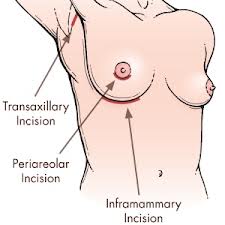 The location of the incision to insert the implant through into the proper breast pocket is often a significant consideration for some women. Some plastic surgeons use a standard incision location for all their patients while others may allow the patient to choose. In reality, the incision (around the nipple, under the breast or through the armpit) is just a location to insert the implant, what is done inside the breast remains the same for all incision locations. As a result, the incision location does not affect recovery or the breast augmentation result. The most common incision location used and one that offers the most direct route to making a submuscular pocket is the inframammary (lower breast fold) incision. For patients who prefer a ‘scarless’ breast augmentation technique or for darker-skinned patients that have concerns about scar hyper pigmentation, the axillary (armpit) incision may be used.
The location of the incision to insert the implant through into the proper breast pocket is often a significant consideration for some women. Some plastic surgeons use a standard incision location for all their patients while others may allow the patient to choose. In reality, the incision (around the nipple, under the breast or through the armpit) is just a location to insert the implant, what is done inside the breast remains the same for all incision locations. As a result, the incision location does not affect recovery or the breast augmentation result. The most common incision location used and one that offers the most direct route to making a submuscular pocket is the inframammary (lower breast fold) incision. For patients who prefer a ‘scarless’ breast augmentation technique or for darker-skinned patients that have concerns about scar hyper pigmentation, the axillary (armpit) incision may be used.
BREAST IMPLANT INSERTION
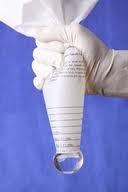
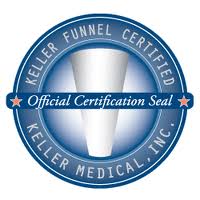 One very innovative and useful silicone gel breast augmentation technique is the use of a funnel insertion device. Because silicone implants are inserted already filled (saline implants are filled after they are inserted) larger skin incisions are needed to pass the implant into position. The Keller Funnel allows even larger silicone implants to be inserted through smaller incisions than in the past. This makes it possible to even place silicone implants through an axillary (armpit) incision. In addition, the funnel allows the implant to go from the box into the breast pocket without being handled by the plastic surgeon (no-touch breast augmentation technique), thus reducing the potential risk of infection.
One very innovative and useful silicone gel breast augmentation technique is the use of a funnel insertion device. Because silicone implants are inserted already filled (saline implants are filled after they are inserted) larger skin incisions are needed to pass the implant into position. The Keller Funnel allows even larger silicone implants to be inserted through smaller incisions than in the past. This makes it possible to even place silicone implants through an axillary (armpit) incision. In addition, the funnel allows the implant to go from the box into the breast pocket without being handled by the plastic surgeon (no-touch breast augmentation technique), thus reducing the potential risk of infection.
ETHNIC CONSIDERATIONS IN BREAST AUGMENTATION
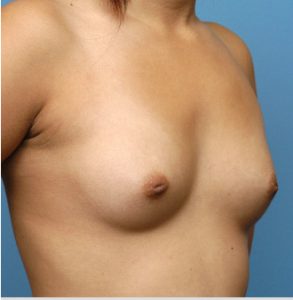
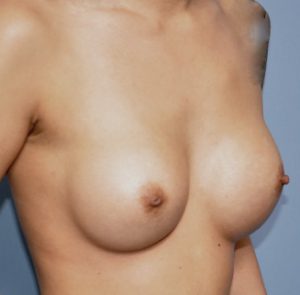 Women from all over the world from almost every known race has undergone breast implant surgery. Just like any woman considering breast enhancement, the volume of the implant used and the subsequent size result is of considerable importance. While each woman has input into the type and size of breast implant that they desire, it is also important to consider the ethnicity of the patient. For some ethnicities a smaller breast implant result is desired which may be more aesthetically desirable with smaller body frames and racial norms for the result to be considered natural in appearance.
Women from all over the world from almost every known race has undergone breast implant surgery. Just like any woman considering breast enhancement, the volume of the implant used and the subsequent size result is of considerable importance. While each woman has input into the type and size of breast implant that they desire, it is also important to consider the ethnicity of the patient. For some ethnicities a smaller breast implant result is desired which may be more aesthetically desirable with smaller body frames and racial norms for the result to be considered natural in appearance.
BREAST AUGMENTATION AFTER BREAST REDUCTION
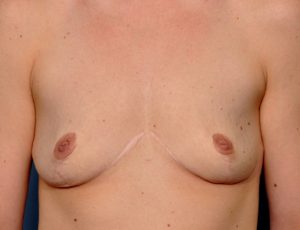
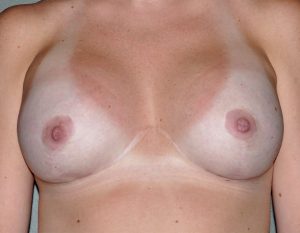 Breast shape and size for women can be variable throughout their lifetime due to a variety of influences. One such major influence is that of breast reduction surgery. While one may have had very large breasts as a teenager or young adult that necessitated a breast reduction to relieve back and neck pain as well as social embarrassment, time may have created an opposite problem. With pregnancies and/or weight loss, the remaining breast tissue may have subsequently shrunk creating a loose sack of skin and a flat chest. Breast implants can quickly bring back some volume to fill out the loose breast skin. It is not rare to have seen a teenager have a breast reduction and then go on decades later to have a breast augmentation.
Breast shape and size for women can be variable throughout their lifetime due to a variety of influences. One such major influence is that of breast reduction surgery. While one may have had very large breasts as a teenager or young adult that necessitated a breast reduction to relieve back and neck pain as well as social embarrassment, time may have created an opposite problem. With pregnancies and/or weight loss, the remaining breast tissue may have subsequently shrunk creating a loose sack of skin and a flat chest. Breast implants can quickly bring back some volume to fill out the loose breast skin. It is not rare to have seen a teenager have a breast reduction and then go on decades later to have a breast augmentation.
BREAST IMPLANT REPLACEMENT
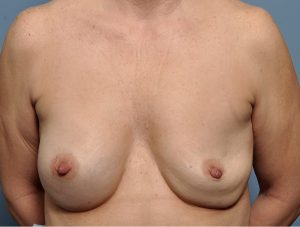
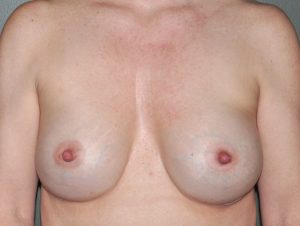 Despite the advances in material technology, few women will have their breast implants last forever. Eventually breast implants will suffer failure due to a loss of integrity of the enveloping bag. A hole or tear can develop after years of use and the device has then formally ‘failed. With saline implants this will result in an immediate or slow loss of breast volume as the liquid leaks out and is absorbed. (i.e., the breast will go flat) With silicone implants, no gel material generally comes out and the breast size remains stable. (known as silent rupture) Silicone gel implant failure may only be discovered in a mammogram or with the onset of some discomfort in the breast.
Despite the advances in material technology, few women will have their breast implants last forever. Eventually breast implants will suffer failure due to a loss of integrity of the enveloping bag. A hole or tear can develop after years of use and the device has then formally ‘failed. With saline implants this will result in an immediate or slow loss of breast volume as the liquid leaks out and is absorbed. (i.e., the breast will go flat) With silicone implants, no gel material generally comes out and the breast size remains stable. (known as silent rupture) Silicone gel implant failure may only be discovered in a mammogram or with the onset of some discomfort in the breast.
While breast implant failure is unavoidable for most, the goods news is that implant replacement is much easier than the original surgery. With an established pocket under the muscle, there is little discomfort in removing the old implant and putting in the new one. One can also go bigger or smaller with their implant size at the same time.
BREAST AUGMENTATION WITH NIPPLE LIFTS
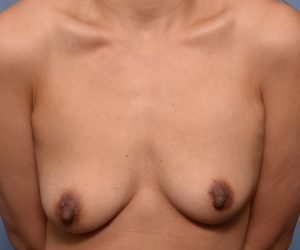
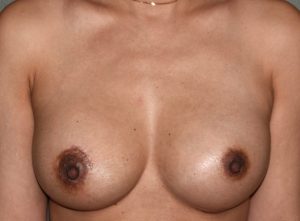 Some women that present for breast augmentation have variables amounts of breast sagging. Breast implants alone will not result in any substantial breast lifting and may in some cases actually worsen the amount of breast sagging as the implants push down the lower breast mound further. This may necessitate the need for some type of a lifting procedure at the same time that the implants are placed. In minor cases of breast sagging, a simple nipple lift (also called a superior crescent mastopexy) can be done in combination with implants to lift the upper edge of the nipple a bit higher.
Some women that present for breast augmentation have variables amounts of breast sagging. Breast implants alone will not result in any substantial breast lifting and may in some cases actually worsen the amount of breast sagging as the implants push down the lower breast mound further. This may necessitate the need for some type of a lifting procedure at the same time that the implants are placed. In minor cases of breast sagging, a simple nipple lift (also called a superior crescent mastopexy) can be done in combination with implants to lift the upper edge of the nipple a bit higher.
NATURAL BREAST AUGMENTATION
![]()
![]() While the concept of natural breast augmentation may refer to an implant that is not too large from the patient’s perspective, it frequently refers to the shape of the augmented breast. This means that the breasts after surgery has a more anatomic form in which the lower half of the breast is fuller than the top half. This breast augmentation result is most consistently achieved by using shaped or lower profile round silicone breast implants . These are silicone implants that come in a variety of base shapes to match that of the patient’s breast base width and height.
While the concept of natural breast augmentation may refer to an implant that is not too large from the patient’s perspective, it frequently refers to the shape of the augmented breast. This means that the breasts after surgery has a more anatomic form in which the lower half of the breast is fuller than the top half. This breast augmentation result is most consistently achieved by using shaped or lower profile round silicone breast implants . These are silicone implants that come in a variety of base shapes to match that of the patient’s breast base width and height.
BREAST AUGMENTATION AND CLEAVAGE
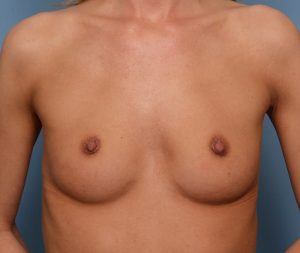
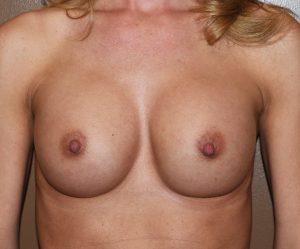 A common question some women ask is whether they will have cleavage after getting breast implants. While it is true that all women will get cleavage as a result of their breast implants in a bra, only a few women will develop unsupported cleavage. (not wearing a bra) The likelihood of obtaining implant cleavage is determined by three factors….how close are the natural breast mounds, what size implant is being placed and which implant pocket is being used. Good cleavage is likely to being obtained if one’s breasts are naturally closer, larger implants are being used and if the implant pocket is above and not below the muscle.
A common question some women ask is whether they will have cleavage after getting breast implants. While it is true that all women will get cleavage as a result of their breast implants in a bra, only a few women will develop unsupported cleavage. (not wearing a bra) The likelihood of obtaining implant cleavage is determined by three factors….how close are the natural breast mounds, what size implant is being placed and which implant pocket is being used. Good cleavage is likely to being obtained if one’s breasts are naturally closer, larger implants are being used and if the implant pocket is above and not below the muscle.
THE EFFECTS OF IMPLANTS IN BREAST ASYMMETRY
While many women that present for breast augmentation have breasts that aren’t perfectly matched, their asymmetries are small and often of no consequence to what happens when the breasts are enlarged with implants. In such small asymmetries the patient may not even know of the differences between the breasts until it is pointed out in an examination. This is particularly true in minor amounts of horizontal nipple asymmetries or small volume differences.
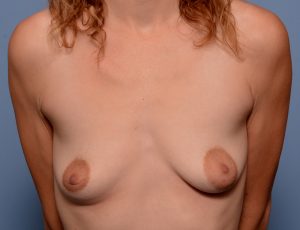
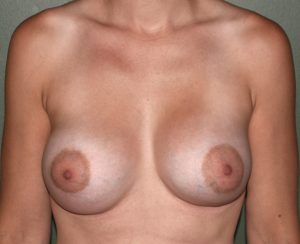 But when the asymmetries between the two breasts are more significant, this is an important issue to review before surgery. Implants fundamentally take what is there and just make it bigger. While small volume differences may be corrected by different size implants, most other asymmetric breast features will not respond so favorably to volume enhancement. Differences in nipple and inframammary fold levels and degrees of sagging between the breast mounds may require additional procedures to provide more complete symmetry improvements. Some women may be willing to accept their asymmetries that remain from the surgery and take a wait and see approach to determine how bothersome they are. Other women desire to address these issues at the time of implant placement.
But when the asymmetries between the two breasts are more significant, this is an important issue to review before surgery. Implants fundamentally take what is there and just make it bigger. While small volume differences may be corrected by different size implants, most other asymmetric breast features will not respond so favorably to volume enhancement. Differences in nipple and inframammary fold levels and degrees of sagging between the breast mounds may require additional procedures to provide more complete symmetry improvements. Some women may be willing to accept their asymmetries that remain from the surgery and take a wait and see approach to determine how bothersome they are. Other women desire to address these issues at the time of implant placement.
THE EFFECTS OF BREAST IMPLANTS ON STRETCH MARKS
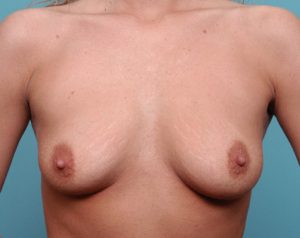
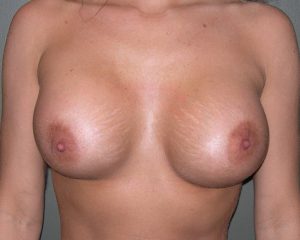 Some women have stretch marks from pregnancies which have a classic radiating pattern from around the nipples out onto the breast mounds. A common question is will having a breast augmentation make them look worse. Expansion of the skin from underlying breast mounds will make stretch marks wider but not necessarily appear worse. In some cases the expansion of the stretch marks can make them less obvious as they get flatter. But in general they do not usually end up looking worse. Rarely the stretch marks turn pinkish in color for a period of time after surgery but usually fades back their previous color as the swelling goes down.
Some women have stretch marks from pregnancies which have a classic radiating pattern from around the nipples out onto the breast mounds. A common question is will having a breast augmentation make them look worse. Expansion of the skin from underlying breast mounds will make stretch marks wider but not necessarily appear worse. In some cases the expansion of the stretch marks can make them less obvious as they get flatter. But in general they do not usually end up looking worse. Rarely the stretch marks turn pinkish in color for a period of time after surgery but usually fades back their previous color as the swelling goes down.
BREAST AUGMENTATION IN PECTUS EXCAVATUM
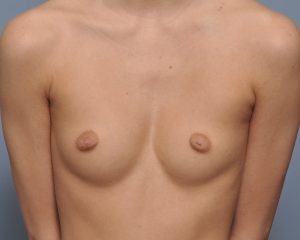
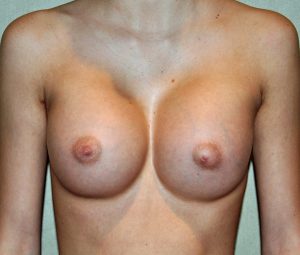 Pectus excavatum is a not uncommon congenital chest wall deformity. When severe it has usually been surgically treated at a younger age. In less severe presentations it appears as a sternal depression and the breasts may be closer together and often underdeveloped. Women often ask whether they can have breast implants with this type of chest wall deformity and, if so, will it make it the sternal depression look worse or their breasts have an unnatural appearance. The answer is such chest wall deformities are not a restriction for surgery and the implants usually makes the sternal depression and chest wall deformity less obvious. Because of the decreased spacing between the breast mounds good cleavage usually results.
Pectus excavatum is a not uncommon congenital chest wall deformity. When severe it has usually been surgically treated at a younger age. In less severe presentations it appears as a sternal depression and the breasts may be closer together and often underdeveloped. Women often ask whether they can have breast implants with this type of chest wall deformity and, if so, will it make it the sternal depression look worse or their breasts have an unnatural appearance. The answer is such chest wall deformities are not a restriction for surgery and the implants usually makes the sternal depression and chest wall deformity less obvious. Because of the decreased spacing between the breast mounds good cleavage usually results.
TRANSGENDER AND MALE BREAST AUGMENTATION
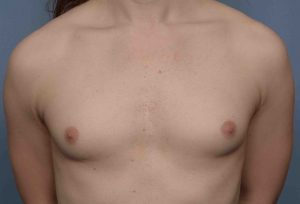
 An important part of body feminization in the transgender male to female patient is breast enhancement. While hormone therapy may create some breast tissue it rarely by itself can create a breast mound of adequate size or shape. Breast implants provide an immediate and effective solution. While much of the techniques of breast augmentation are the same as in the cis-female, there are several technical differences. With naturally tighter chest tissues that have never had breast development, initial implant sizes may be less than the patient desires. Larger breast implant sizes may require a staged approach to get there safely. Also because of lack of natural breast development the level of the inframammary fold must be substantially lowered. To do so effectively an inframammary incisional approach is usually best used.
An important part of body feminization in the transgender male to female patient is breast enhancement. While hormone therapy may create some breast tissue it rarely by itself can create a breast mound of adequate size or shape. Breast implants provide an immediate and effective solution. While much of the techniques of breast augmentation are the same as in the cis-female, there are several technical differences. With naturally tighter chest tissues that have never had breast development, initial implant sizes may be less than the patient desires. Larger breast implant sizes may require a staged approach to get there safely. Also because of lack of natural breast development the level of the inframammary fold must be substantially lowered. To do so effectively an inframammary incisional approach is usually best used.
Breast augmentation in the non-transgender male can be done just as effectively as in the transgender male to female patient. Given that it is the identical surgery as the transgender patient the same considerations of implant selection and placement technique apply.
RAPID RECOVERY AFTER BREAST AUGMENTATION
This newer approach to breast augmentation, combined with aggressive physical therapy, has allowed a lot of women to return to their normal activities within 24 to 48 hours after surgery. In addition it can decrease, if not eliminate, the need for narcotic pain medication. No pain pump or other costly or uncomfortable devices are needed. With the Rapid Recovery technique, you may enjoy the benefits of your breast augmentation sooner… and be a lot more comfortable than you thought possible!
 Breast augmentation is the lifting up of your chest muscle and placing an implant partially underneath it. As the pocket into which a breast implant is placed controls the final shape of the breast, recovery after breast augmentation is really muscular in nature. Gentle surgical technique, anti-inflammatory medication, and immediate physical therapy helps you recover faster…and with less pain. Early moving and stretching of an injured muscle is the key to a faster recovery after breast augmentation. You can’t hurt the breast implants by using your arm and chest muscles and early movement will not be responsible for an implant getting out of place. These range of arm motion exercises begin on the night of surgery and should continue for one week after the surgery.
Breast augmentation is the lifting up of your chest muscle and placing an implant partially underneath it. As the pocket into which a breast implant is placed controls the final shape of the breast, recovery after breast augmentation is really muscular in nature. Gentle surgical technique, anti-inflammatory medication, and immediate physical therapy helps you recover faster…and with less pain. Early moving and stretching of an injured muscle is the key to a faster recovery after breast augmentation. You can’t hurt the breast implants by using your arm and chest muscles and early movement will not be responsible for an implant getting out of place. These range of arm motion exercises begin on the night of surgery and should continue for one week after the surgery.
In addition to performing breast augmentation and breast reduction, Dr. Eppley also helps breast lift patients improve the shape of their sagging breasts.
Breast Augmentation – Before Surgery
An examination of the breasts is made to determine their shape and size and the most effective surgical approach. Implants alone may be inadequate for those women with significant breast sagging and a breast lift may need to be considered with implants in these cases. A thorough understanding of the advantages and disadvantages of saline and silicone gel implants should be appreciated by the patient so they can make the right choice for themselves. Mammograms, in certain patients, may be required prior to surgery. Particular importance is paid to the amount of symmetry between the breasts and whether any significant droopiness (ptosis) exists, both of which can affect the final cosmetic result. Preoperative instructions include the avoidance of any drugs which contain aspirin two weeks prior to surgery to minimize the possibility of excess bleeding during or after surgery.
Complications from breast implant surgery such as infection and problems with healing of the incisions are quite rare. The important long-term risks of implant deflation (with the use of saline implants), capsular contracture (breast becomes too firm due to the excessive formation of scar around the implant), and asymmetry (differences between the two breasts) will be thoroughly discussed with you before surgery.
Breast Augmentation – The Operation
The placement of breast implants is performed as an outpatient procedure under general anesthesia. Several different types of incisions may be used through which to place the breast implant. These include the inframammary (lower portion of the breast in the fold), areolar (lower portion of the dark pink area surrounding the nipple), and transaxillary (up in the armpit). They are certain advantages and disadvantages with each incisional approach and these will have been discussed with you in your initial consultation appointment. As a general rule, saline implants can be placed through any of the incisions, silicone gel implants are usually placed through the inframammary fold although some smaller sizes may be able to be placed through the armpit approach.
After the incision is made, a pocket is created either under the breast tissue or beneath the chest wall muscle to receive the implant. Most commonly, implants are placed beneath the chest wall (pectoralis) muscle to better cover the top portion of the implant and decrease the potential risk of capsular contracture (hardness) after surgery. This is known as the dual plane technique, where the implant is only partially covered by the pectoralis muscle.
Saline implants will be filled with a saline solution which is a normal constituent of your body’s fluids and poses absolutely no adverse health risks. The implants will be inflated to the desired size after insertion and checked for symmetry between both breasts. Silicone gel implants are prefilled with FDA-approved and safe silicone gel material which also poses no health risks. Because silicone breast implants are pre-filled, this is why the incision through which they are placed must be bigger. Using the Keller funnel device, even large silicone implants can now be placed through smaller skin incisions than in the past. After the implants are in proper position in the breast pocket, the incisions will then be closed with dissolvable sutures. Average time of surgery is one hour.
Breast Augmentation Recovery
After completion of the operation, patients are awakened and sent home when they have adequately recovered from the anesthesia. The patient will be sent home in a surgical bra which is to be worn for up to one week after surgery. After that, any non-underwire bra can be worn that is not too tight. Pain associated with the procedure is related to the lifting up of the pectoralis muscle for implant placement. Pain medication and antibiotic prescriptions will be provided. All patients are put on our innovative RAPID RECOVERY BREAST AUGMENTATION program which begins with range of motion exercises the first night. The goal of this program is to be back to your normal lifestyle as soon as possible.
Swelling and bruising of the breasts are variable between patients but swelling is far more common than significant bruising. This will completely disappear within a few weeks and the scars from the incisions, although permanent, will blend into the surrounding area in three to six months after surgery.

North Meridian Medical Building
Address:
12188-A North Meridian St.
Suite 310
Carmel, IN 46032
Contact Us:
Phone: (317) 706-4444
WhatsApp: (317) 941-8237
